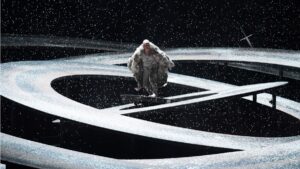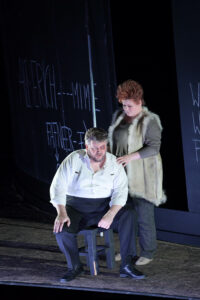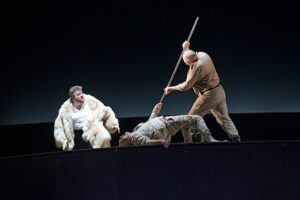It is hard to do greater harm to the ‘new mythology’ of Wagner than to dress it in the costume of social criticism – to interpret Der Ring des Nibelungen through the prism of satire on the bourgeoisie, nationalist ideology or the slogans of militant Communism. Wagner created his total work ‘from the most abysmal depths of the spirit’, as a treatise on human nature – a treatise cut to fit the era of a modernity stripped of mystery and facing the complete loss of myth-creating potential. This was understood perfectly by Wieland Wagner, who cleansed the Ring of meanings imposed upon the tetralogy by the Nazi propaganda machine, and followed in the footsteps of Edward Gordon Craig, who appealed in his vision of theatre to a longing for imagination and things not of this world. The great reformer of Bayreuther Festspiele restored the status of a symbol to the Wagnerian dramas, staging them in a nearly empty, geometricized space painted with light. He gained a legion of imitators and epigones, but few have managed to approach the mastery with which he weeded out superfluous details for the sake of a clear message.
Perhaps the most capable advocate of a ‘pure’ concept for the production of Wagner’s tetralogy was Austrian stage designer Günther Schneider-Siemssen, from the beginning of the 1960s onward one of Herbert von Karajan’s closest co-workers and the creator of nearly 30 designs for productions stage-directed personally by the charismatic conductor. In March 1967, their production of Die Walküre opened the first Osterfest in Salzburg. The so-called Karajan Ring, realized in its entirety by 1970, has become a legend of opera theatre. In the 1980s, it made its way to the stage of the Metropolitan Opera, this time directed by Otto Schenk. Schneider-Siemssen’s symbolic stage design – constructed around spiral spatial forms and complemented by video projections novel for their time and by spectacular lighting design – brought to mind the mythic cosmos: a place suspended between the world of the gods and that of people, between existence and non-existence. In 2017, in honour of the Osterfest’s 50th birthday, the Salzburg Die Walküre saw a ‘remastered’ reconstruction by Dresden-born stage designer Jens Kilian – who, like Schneider-Siemssen, took his first steps in a film set design studio – and Bulgarian-German stage director Vera Nemirova, a student of Ruth Berghaus and her former assistant Peter Konwitschny.
Peter Wedd (Siegmund). Photo: Barbara Aumüller
The two of them already had the experience of a Ring realized for Oper Frankfurt (2010–12) under their belts. The main driving force of this production is, again, the stage design concept – inspired by the earlier visions of Wieland Wagner and Schneider-Siemssen, but sufficiently original and masterful in its simplicity to gain an independent position in the history of productions of this masterpiece. An indispensable element of all four parts of the Frankfurt tetralogy is the ‘stage sculpture’ invented by Kilian and superbly lit by Olaf Winter – a set of independently moving concentric circles, awakening ambiguous associations: with the titular ring forged from Rhine gold, with the rings of Saturn and other heavenly bodies, with the implacable symmetry of nature. In such a setting – fortunately for Wagner’s work – the stage director will not indulge in any craziness, especially in Die Walküre, the most intimate and ‘human’ part of Der Ring des Nibelungen.
James Rutherford (Wotan) and Christiane Libor (Brünnhilde). Photo: Barbara Aumüller
Nemirova therefore had to stifle the temptation to fill the stage with the clutter characteristic of Regieoper, and follow the stage designer’s vision. In Kilian’s Die Walküre, every now and then the rings arrange themselves in the suggestive shape of a tree stump: that of the ash tree Yggdrasil, the axis of the universe, the meeting point of all worlds from Nordic mythology. Hunding’s home is located under the roots; the sword plunged into the tree stump is stuck beneath the ceiling, and its hilt protrudes outside this gloomy world. All of the quarrels, disagreements and misunderstandings among the deities play out on the construction’s several levels. The rings set in motion intensify the feeling of uncertainty and danger. Not much more is needed in order to shape the narrative according to the composer’s intentions. All that was left for Nemirova to do was to sketch out the relationships between the characters, in which she was also helped by Ingeborg Bernerth’s costumes, suspended outside time and making use of discreet symbolism. A bit of director’s theatre – but economical, tasteful and, despite everything, in line with the score – wafted in only at the beginning of Act III, in the episode of the ride of the Valkyries, which was accompanied by a contemporary scene of a military funeral playing out on the lowest level of Kilian’s ‘machine’. Leaving aside its minor, basically superfluous allusions to the theatre of Konwitschny and Decker, Nemirova’s concept turned out to be one of the clearest with which I have dealt in the past quarter century. It is worth adding that the stage director and stage designer tied their Die Walküre together with a beautiful narrative bracket: from the prologue with Siegmund, lost in a blizzard among the irregularly orbiting rings, to the finale with a ring of real fire, lowered from the stage rafters over Brünnhilde, who has been put to sleep by Wotan.
James Rutherford, Peter Wedd and Taras Shtonda (Hunding). Photo: Barbara Aumüller
Also conducive to a coherent and logical staging were the performers. In this year’s revival, Amber Wagner – a Sieglinde endowed with a dark, overtone-rich soprano – received an ideal partner in the person of Peter Wedd, who sang Siegmund a year ago in Karlsruhe. His dense, balanced tenor, making masterful use of chiaroscuro technique, formed an ideal complement to Wagner’s voice, bringing to mind associations with the legendary Resnik/Vinay pairing in Die Walküre under the baton of Clemens Krauss. Taras Shtonda, debuting in the role of Hunding, created the character of a scoundrel of the darkest type – a gruff, husky bass, perhaps a bit too weakly-supported in the lower register. The other soloists – chief among them, the velvet-voiced James Rutherford (Wotan) and Christiane Libor (Brünnhilde), phenomenal in both character and voice – reprised their successes from previous years. Sebastian Weigle led the orchestra at relatively slow tempi (especially in Act I), but taking extraordinary care with the pulse and texture – his perspective in many ways resembled Karajan’s ‘lyric cosmos’, equally free of pathos and other unauthorized stylistic accretions as the pure stage visions of Kilian and Schneider-Siemssen.
Absorbing the Frankfurt Die Walküre with all of my senses, I always return in my mind to the economical and laser-precise prose of W. G. Sebald, the author of the brilliant – and suggestively named – The Rings of Saturn. A good story cannot bear haste or mess. A good myth – especially one for new, terrible times – must be clear as crystal.
Translated by: Karol Thornton-Remiszewski



